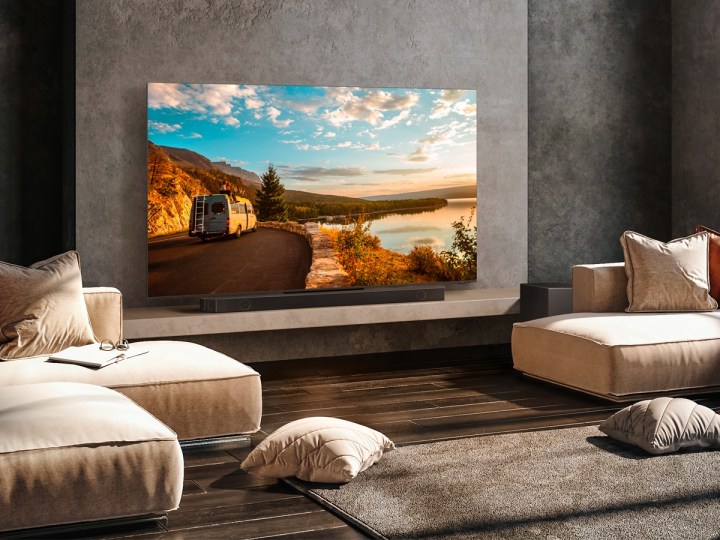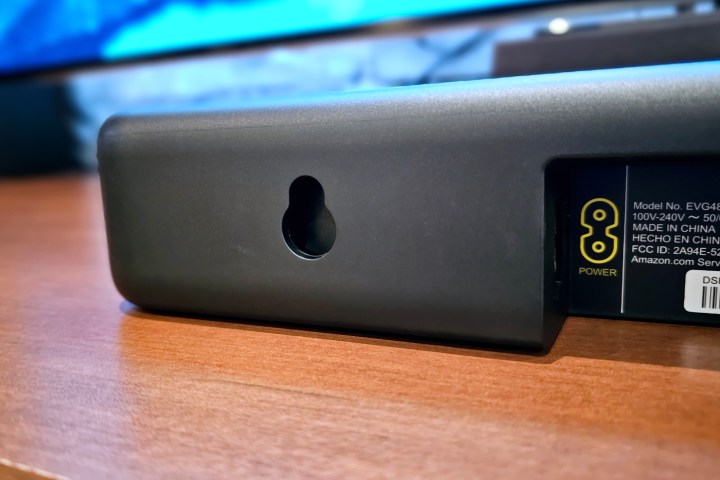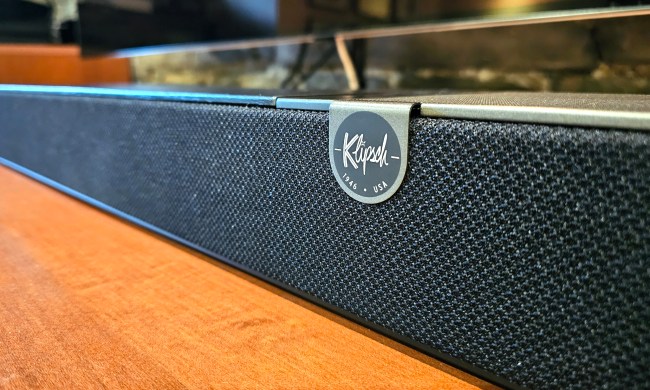While some of the best TVs coming out today have upped their game when it comes to their built-in sound, we’re still a few leaps and bounds away from not having to suggest new TV buyers invest in a soundbar to bring an improved sound experience to your movie, TV, and sports watching at home.
Hence, the need for this guide on how to choose the best soundbar for you remains, and we’re happy to oblige. Soundbars have been around for a minute, and you can check out some our favorites in our best soundbars guide. We’ve even got a guide specific to soundbars that come with subwoofers. But like most consumer tech items, buying a soundbar can be a daunting endeavor, mostly because there are so many options.
We’ve put together this guide that touches on some of the most salient soundbar criteria you should be addressing.

What size soundbar do I need?
Since soundbars come in a variety of shapes and sizes, you need to determine the best size for your TV. Some people prefer that their soundbar is the same width as their television, while others are on the hunt for bigger. And while it’s a personal preference in the end, the size of a soundbar is largely determined by how many drivers and/or channels there are in any given soundbar — the more drivers there are, the bigger it can be, but not always (it’s complicated).
We get into this in more detail below, but it’s up to you to make sure that whatever soundbar you buy has the best balance between the number of drivers for the features you want, and that will fit under your TV, either mounted on the wall or on your media console.
Do I need a subwoofer?
Regardless of which soundbar you choose, it’ll be a major improvement over the internal speakers of just about any television. Still, there are decisions to be made, and one of them is extra important: Should you get a soundbar with a subwoofer, or without one?

Subwoofers are speaker drivers dedicated to the reproduction of low-frequency audio — think rumbling bass, exploding bombs, the whump-whump of a helicopter’s blades. A soundbar with a subwoofer will add punch and rumble to TV shows and movies, creating a fuller sound and more effectively projecting audio throughout the room. If you plan on watching lots of action movies or movies with epic music, you’ll likely want a subwoofer.
Some soundbars come with dedicated subwoofers (most connect wirelessly, though some require a direct-wired connection), but in some cases, you’re better off purchasing them separately. Make sure to do some research — our subwoofers buying guide is one resource. If you decide to buy a third-party dedicated subwoofer, make sure your soundbar supports it — not all soundbars have a dedicated subwoofer output.
In other cases, like the Sony HT-S2000, the subwoofers contained in the soundbar itself are powerful enough to deliver all but the most sofa-shaking low frequencies. Even the Sonos Arc and Klipsch Flexus Core 200 are arguably capable of holding their own sans-subwoofer.
Connections
For the most part, you’ll need just one cable to connect a soundbar with your TV. Some soundbars rely on optical cables, which work fine. Still, HDMI is preferred. The HDMI interface supports more audio formats than the optical, which effectively means you’ll get higher quality sound that’s more immersive with HDMI. Here’s a basic chart for what audio formats are supported by Optical, HDMI ARC, and HDMI eARC.
Optical |
HDMI (ARC) |
HDMI (eARC) |
| Stereo | Stereo | Stereo |
| Dolby Digital |
Dolby Digital |
Dolby Digital |
| DTS | DTS | DTS |
| DTS:X | DTS:X | |
| Dolby Digital Plus | DTS-HD Master Audio | |
| Dolby Atmos | Dolby Digital Plus | |
| Dolby Atmos | ||
| Dolby True HD |
But HDMI connections aren’t all equal, especially when it comes to soundbars. To connect a soundbar to a TV over HDMI, your TV needs to support HDMI ARC (Audio Return Channel) or HDMI eARC (Enhanced Audio Return Channel) — some older TVs don’t have this feature. If your TV doesn’t have it, you’ll need to stick with an optical connection.
Keep in mind, if you connect your soundbar via HDMI, you’ve now got one less HDMI port on your TV for devices like streaming media players, Blu-ray players, or cable boxes. To compensate, some soundbars offer an HDMI input, and some offer more than one, which effectively turns them into mini AV receivers. But some soundbars, like the Sonos Arc, don’t have any HDMI inputs. If you’re already running low on HDMI ports, that’s something to keep in mind.
The only solution (other than buying a soundbar with multiple HDMI inputs) is to buy an HDMI switcher, which can turn one HDMI port into two, three, four, or more — but this increases the complexity of your setup, something which a soundbar is meant to prevent.
Check out our guide on how to connect your soundbar to a TV for a detailed look at all of your options.
Mounting options

One of the best parts about owning a modern TV is the ability to mount it on the wall. And guess what? You’ll be able to mount your soundbar on the wall too, but there are a few important things you should think about before doing so.
First and foremost, it’s a good idea to know what kind of wall mount you’re going to buy for your TV, or what type of mount an existing wall-mounted set is using. This is because flat wall mounts (the type that place your TV as close to the wall as possible) and tilting wall mounts (the kind that let you tilt your TV up and down a few degrees) are not going to pull off the wall. So if you decide you’d like to use the manufacturer-supplied mounting hardware to mount your soundbar right below your TV, you’ll just want to make sure you’re centering it below your TV.
And if you’re a stickler for wire-free aesthetics (we totally get it), you may want to invest in a wire cover to hide the HDMI or optical connection that runs from the soundbar to your TV.
Now. if you’re going to be using a full-motion wall mount (the kind that pull off the wall, turn left and right, and tilt up and down), it might be a better idea to buy a soundbar mounting kit, instead of mounting directly to the wall.
Soundbar mounting kits actually attach to your TV’s wall-mounting hardware, so when you decide you’d like to move your TV to face a different part of your living room (or another room entirely), your soundbar will move with it. This isn’t to say that you have to use a soundbar mounting kit if you’re using a full motion wall-mount for your TV. Even if your TV is faced away from your typical viewing area, most soundbars are capable of delivering audio to an entire room, instead of just a dead-on listening space.
Channels and Dolby Atmos

When shopping for soundbars for your home theater, you’ll probably come across some confusing numbers. Labels like “2.0,” “3.1,” or “5.1” are there to let you know A) how many channels a soundbar has and B) whether or not it has a subwoofer.
The first number (before the period) refers to the number of channels, and the number after the period tells you whether there’s a subwoofer (1) or not (0). If a soundbar has only two channels, that means a left and a right channel. If it has three channels, the third is a center channel, which improves dialog clarity. Five adds channels for rear or surround sound speakers.
Often, a soundbar system will come with a wireless subwoofer or separate subwoofer and, in some cases, even wireless satellite speakers. These don’t need to connect physically with the soundbar itself, but they’ll need a power source, so you’ll have to position them near wall outlets (or get creative).
But here’s where it can get a little tricky: A soundbar can claim to be 2.1, 3.1. or even 5.1 — even if it doesn’t come with a subwoofer. As long as the soundbar has dedicated low-frequency drivers, it can still claim “.1” status.
If there’s a third number — i.e., 5.1.4 — that means the soundbar supports Dolby Atmos surround sound and/or DTS:X. The final number refers to the number of dedicated drivers that fire upwards at the ceiling, bouncing sound down to create an enveloping effect. Early Dolby Atmos models were reasonably effective at simulating dedicated height-channel speakers, but the newest Atmos soundbars are incredible. Atmos is the most popular surround sound technology, capable of processing 128 distinct objects in a given scene.
But wait, why do I see some soundbars claiming to offer Dolby Atmos sound, yet with as few as two channels? This is the curious thing about Dolby Atmos. It can be reproduced using dedicated drivers within a single speaker (e.g., Sonos Arc), or it can be reproduced using separate speakers, or it can be reproduced “virtually” using as few as two channels in a single speaker.
Naturally, there’s a wide range of quality in these situations. We’d argue that if you’re a Dolby Atmos fanatic, there’s simply no substitute for dedicated speakers placed correctly around your room. However, it’s remarkable just how good virtualized Atmos can be.
Whole-home audio and Bluetooth
Soundbars are increasingly being used for listening to music as much as for listening to your TV. This is especially true in smaller houses or condos. Most new soundbars support Bluetooth connectivity and streaming from your smartphone, tablet, or computer, making it super-simple to hear your Spotify or other music on a bigger speaker. However, more sophisticated options exist.
Sonos, Bluesound, Bose, Yamaha, and many others offer soundbars that can be linked to whole-home wireless music systems over Wi-Fi. If you think you may want to expand into a larger wireless music system in the future (or if you already own other Wi-Fi audio components from these brands), it makes sense to consider one of these models before you buy.
Smart soundbars

Soundbars are no longer all about sound. The latest models from Amazon and Roku now include smart software, such as Roku OS, and even voice assistants like Google Assistant and Alexa. These are a good option for those who want to give their aging TVs the latest in streaming services and home automation, without complicating their setup with additional streaming devices and cables. These smart soundbars are very convenient but don’t forget: your main mission should be to get yourself better sound. It’s not worth buying a smart soundbar that doesn’t meet your expectations for sound quality.
IR sensors and placement

Assuming you want to control your TV (you do), you’ll need to be careful with where you place a soundbar. Typically, soundbars sit directly below your TV — even mounted on the wall, if that’s where the TV is. But if you’re using an entertainment stand, you don’t want the soundbar sitting on it blocking your TV’s infrared (IR) sensor, which is where the remote control sends its signal.
Some soundbars come with IR repeaters; these pass the signal through the soundbar itself to the TV’s sensor. If yours has one, awesome — just make sure the soundbar isn’t obscuring the screen. Generally speaking, you want a soundbar that’s approximately the same width as your TV; soundbar proportions are mostly an aesthetic factor, though, and shouldn’t be a deal-breaker.
When talking about placement, it is also important to note if you want a soundbar with a front-panel display. While this is a nice feature, it isn’t necessarily a must-have. Not many soundbars have a true front display, so you don’t get much in the way of visual feedback when you are turning up the volume.
Dialogue clarity

One of the most common issues people have with the built-in speakers on TVs is the lack of crisp, clear dialogue. The use of complex, multichannel surround sound is making human speech increasingly more difficult to hear. Unfortunately, some soundbars make this worse, not better.
There’s been an increasing trend lately toward smaller soundbars and soundbar-format speakers that focus on making speech more intelligible, such as the customizable Samsung HW-Q990D. Even speakers without the HW-Q990D’s speech-enhancement features, like the Sonos Beam (Gen 2) or the Roku Streambar, can help make dialogue clearer simply by directing more higher-frequency sounds directly toward your viewing spot.
If you need improved dialogue clarity for everyone in the room, these TV speakers can do the trick. But if you’re looking for more personalization, you’ll want soundbars like the Bose soundbar 300, 500, and 700 speakers that allow connection to a set of Bluetooth headphones. Whether you use the headphones in tandem with the speaker or on their own, it’s incredibly effective.



